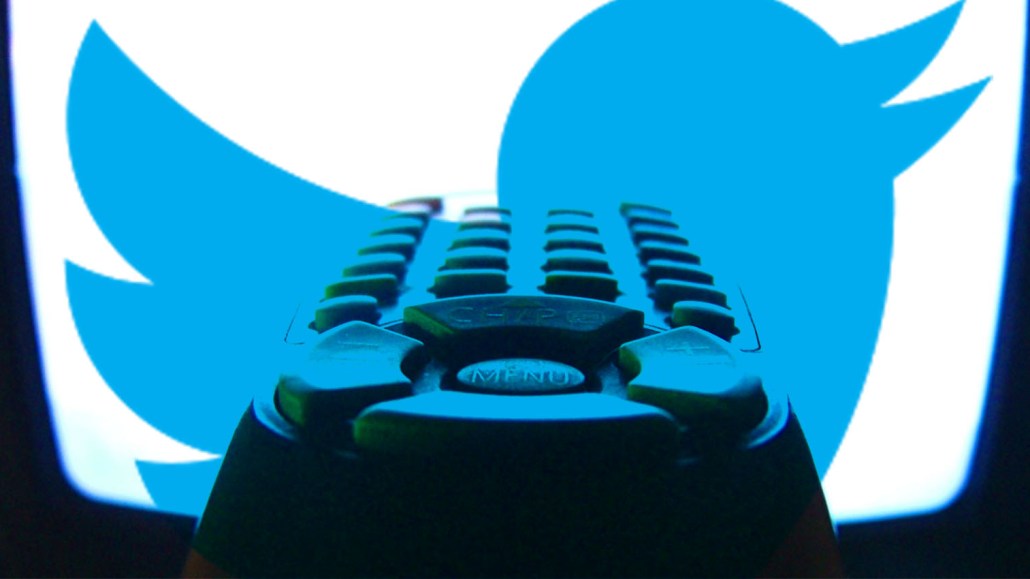
Our coverage of Advertising Week is brought to you by Dstillery, the former Media6Degrees. Dstillery is at the forefront of advertising technology, pioneering new ways to create brand value for marketers by extracting signals from the complete customer journey and activating them across all screens.
If you haven’t heard, Twitter’s got an IPO in the offing. Right now, the message to Wall Street about its media business is a twofer: mobile and TV.
The mobile part, buttressed by its puchase of MoPub, is farther along than TV, a nut that’s long been tough to crack for many Internet companies. It’s telling then that Twitter used its marquee placement at Advertising Week to trumpet its positioning as the “social soundtrack” to television. It used some eye-catching graphics to tell an intriguing data story on the interplay between tweets and TV viewership, and the “tidal wave” of social activity TV events produce. On the line are billions in ad spending.
“Tweets drive discovery, ratings, and engagement for networks and advertisers, and that means more tweets. It’s a virtuous cycle,” Matt Derella, Twitter’s vp of sales, told a room full of ad industry folks. “We want to be the preeminent compliment to the TV experience. The social soundtrack is about TV multiplied by Twitter.”
Ad position: web_incontent_pos1
The pitch is slick, and one that’s supported by the numbers. Twitter has reams of data linking its users’ activity on the platform to TV consumption and habits. Seven in 10 TV-related tweets occur during programs as opposed to commercials, for example, which the company presented as proof that tweeting doesn’t distract viewers from TV ads. Meanwhile, some advertisers – like VW and Pepsi, among others – have seen a 58 percent higher purchase intent when they buy promoted tweets targeted to users that saw their TV commercials, for example.
A cursory glance at the network during a live football game or a cultural event like the Oscars tells the story equally as well. More TV-related conversations are happening in public on Twitter than on any other social platform. That’s valuable, and Twitter knows it. The partnership Twitter struck with Nielsen is designed to bear this out. The Nielsen angle is important, since it’s a pivotal company in the TV world, used as the measurement standard.
But Twitter has a ways to go before it can really crack big TV budgets. It has great traction among the media and plugged-in social and tech scenes, but it still has work to do in convincing broadcasters and big brands that it can really make a difference.
Ad position: web_incontent_pos2
That’s why it was eager to trumpet its new deal with CBS. The pair plan to push content out across the social network to help drive audience engagement and tune-in around TV content, but also to unlock opportunities for brands in the process. Twitter says advertisers are “queueing up” to integrate their messaging with Twitter-specific content from CBS, such as “60 Minutes in 60 Seconds,” for example.
Twitter is now aggressively courting both TV networks and marketers with what it calls its “Amplify” division in an attempt to turn its knowledge of users’ TV habits into revenues.
“Amplify is about turning the volume up on the social soundtrack,” said Twitter’s Glenn Brown, who heads up the initiative. “It’s about extending the audience for our broadcast partners, and giving brands an opportunity to come along too.”
Twitter’s foray into TV remains in it’s early stages, but the formalization of its offerings speaks the potential it sees there. It’s clearly thinking heavily about TV as it rolls out new ad products and adjusts its monetization strategies ahead of an expected 2014 IPO. TV is no longer just one of many supporting pillars for Twitter. It’s rapidly becoming a foundation.
More in Media

NewFronts Briefing: Samsung, Condé Nast, Roku focus presentations on new ad formats and category-specific inventory
Day two of IAB’s NewFronts featured presentations from Samsung, Condé Nast and Roku, highlighting new partnerships, ad formats and inventory, as well as new AI capabilities.

The Athletic to raise ad prices as it paces to hit 3 million newsletter subscribers
The New York Times’ sports site The Athletic is about to hit 3 million total newsletter subscribers. It plans to raise ad prices as as a result of this nearly 20% year over year increase.

NewFronts Briefing: Google, Vizio and news publishers pitch marketers with new ad offerings and range of content categories
Day one of the 2024 IAB NewFronts featured presentations from Google and Vizio, as well as a spotlight on news publishers.
Ad position: web_bfu
